- Home
- Peter Matthiessen
The Cloud Forest Page 8
The Cloud Forest Read online
Page 8
In the villages, by evening, the Indians were totally drunk, and there were many fallen; even the fallen were unsmiling. In this state the Quechua looks more slack-jawed and brutish than the most primitive man imaginable. (A team of American psychiatrists—why is it, of recent years, that Americans are always said to operate in “teams,” as if an individual American, without his insipid “togetherness,” would be helpless?—contrived last year to administer the Rorschach test to Quechuas and “proved,” to the satisfaction of my informant, that these people are rife with hatreds and resentments—of the peruanos, presumably. But they are so subdued by their own poverty, and by their failure to realize how very numerous they are, that a Quechua revolution, while one day inevitable, remains remote. In dealing with them it is hard to make out whether they are as stupid as they seem or just perverse; the Quechua laborer for one of my friends in Lima was told over and over again not to water the flowers in the heat of the day, when the soil would harden like adobe, but he went right on doing it, patiently destroying the garden. One day his employer, observing this, rushed out in despair and shook the man. “How many times,” he shouted, “have I told you not to do that!” The Quechua gaped at him a moment. “Eight or nine times,” he murmured sadly.)
Beyond Anta, in a eucalyptus grove, some people were dancing to a sad, slow huaino of Peru; when we paused to watch, they brought us beer, which the driver and myself and a friend of the driver we had picked up during the day drank heartily.
Through various causes, not the least of these some remarkably bad planning, I crossed the Andes nine times in five months, at various points from northern Peru to Tierra del Fuego; also I traveled them overland, in three installments, from Cochabamba in central Bolivia to a point well past Quillabamba in south-central Peru. The last part of this journey, from Cuzco north to Machu Picchu and Quillabamba, occurred in early April; from the mountains I went on down the Urubamba River into the jungle on an errand described in another chapter.
From Cuzco the small Diesel car to Machu Picchu climbs in a series of switchbacks to the high plateaus which surround the city, passing upward through groves of eucalyptus trees to the open slopes; it was April ninth, a clean, clear mountain day, and banks of blue lupine, yellow daisies, and other flowers reminiscent of our own alpine tundras in North America crowded almost to the windows. Near Anta the track crosses the old stone Inca highway—at twelve thousand feet, this is the highest elevation of the railway—and starts on its long descent, winding down across the bare puna and into the deep Pachar Canyon, which opens eventually on the Urubamba Valley. In the canyon the flowers change. There are several vivid red varieties, and one of these is the so-called Inca flower or cantuta. Toward the foot of the canyon the seas of yellow broom make their appearance; in the valley itself, as the banks steepen into canyons and the river plunges down around boulders, the broom is replaced by the strange mosses, cacti, and gray air plants. The river gains rapidly in speed, from the slow rush at Ollantaitambo, where a base of mighty Inca stones supports the modern bridge, to the swift plunge of white water into the deepening gorges which extend to Machu Picchu. The stream boulders are multicolored: white marble and gray limestone, with red porphyries and blackish slates. North of Ollantaitambo a bright snow peak peered over the dark shoulders of the mountains ahead; it was still in view when the outriders of the tropic zone, acacias and strangler figs, appeared, and a small flock of green parakeets whisked screeching up the valley, like heralds of the montaña—the “high jungle” in the eastern foothills of the Andes. Long shreds of cloud settled into the ravines, and the overhanging walls climbed higher, until the train hurried along in shadow, like an ant in a deep crack.
At an arbitrary point, it seemed, there was a siding and a hut, and the ferrocarril stopped. High above, visible in the outline of the rim only because one knew it was there, was Machu Picchu; through the dark mountain passes which surrounded it the fog poured like smoke.
To reach the ruins one crosses a footbridge over the torrent and ascends the mountainside in a small bus. The climb from the river is said to be three thousand feet, and this is not difficult to believe; the bus took more than twenty minutes to go a lateral distance from the river of a few hundred yards. At the summit a modern lodge has been erected, rather too close to the ruins for my taste; the latter stretched away along the spine of the ridge and extended upward to a sort of outpost on the very peak of Huayna Picchu. This great dark cone stands guard over the roofless city, where grasses blow and brilliant flowers bloom in the dead houses. Far below, the Urubamba winds around the base of Huayna Picchu like a brown string; other peaks, dark and green, crowd forward from the north, east, and south, the ravines between them filled with flowing mist. This is an impossible terrain, impossibly steep and inhospitable and, in the end, oppressive. (In situ, the dispute as to whether the Machu Picchans were Inca or pre-Inca seems very much beside the point. When Hiram Bingham located the rumored city, an Indian family still farmed the overgrown terraces, which suggests the interesting possibility that Machu Picchu, lost in its clouds, has always been inhabited and, to judge from the numbers of Germans and Americans who range it now with their clean limbs and glittering equipment, always will be.) And it is Huayna Picchu and the dark masses, the restless clouds prowling the peaks and the dreadful plunge to the swift river—the mystery, indeed, as to why and when a people would come here to live and why so suddenly, as it is thought, desert the place—which make this ruin so remarkable: if one can separate it from its surroundings and its mystery, Machu Picchu itself, despite its extent and its excellent state of repair, is less noble and less moving than Sacsahuaman, where stupendous monoliths lie juxtaposed to a living city. A visitor there five centuries ago, like the visitor today, would have known the click on stone of llama hoofs descending past it down to Cuzco, the far, solitary red of a cap or poncho, still as an alpine flower against the bleak tone poem of the puna, the lonely fluting of an Indian herdsman, playing the thin high huaino of the sierra with all the power of his muted soul.
The train south to Lake Titicaca and Bolivia leaves Cuzco at 7:30 in the morning, climbing gradually onto the puna. This land much resembles parts of Wyoming and Montana and, higher still, the foothills of Mount McKinley—the same blue lupine and bunch grass, dwarf willow and alder, of our own alpine tundra. But there are many unfamiliar flowers, including a lovely species of silver blue, in clumps, and yucca cactus, and the sage-like tola, and representatives of bird families not usually found at these altitudes in North America—coot, and a variety of hawks, and white egrets, and the serranita gull, and, most astonishing of all, their color reflected in a long, shallow lake beneath snow peaks, a flock of forty or more flamingoes. The pink of these strange birds as they rise against the distant snowfields is an ornithological incongruity beyond description.
Much of the day it rained, and in the cold mountain fields the Indians sat on rocks, stolid as owls. The spot of red which signaled a distant herdsman was present in every distance, like an emblem of Inca days. Here and there, skulking in a ravine or padding along under a hillside, a solitary black sheep dog, semi-feral; these animals were often miles from the nearest hut or herd of llama. A lone horseman—horses are uncommon at this altitude—a far glacier, a large wheeling bird …
And in the station at Juliacao I could not open my window in time to give money to a blind old beggar. The pretty Indian child leading her, shuffling along underneath the window as the train drew out of the station, smiled a forlorn smile of understanding. The little girl stopped at last and waved, and the wave stayed with me all the rest of that long day.
The train arrived at Puno after dark; the passengers for Bolivia went through customs before boarding the lake steamer Inca. In order to make the most of its tiny staterooms, the Inca travels only at night, which is very unfortunate indeed. One would like to contemplate Titicaca, which, at 12,000 feet, is the highest large body of water in the world—it is 138 miles long, in fact, by 69 miles wide, and
at sunrise the Inca was still trudging down its length, passing close by the sacred Islands of the Sun and Moon. It was a cold, clear morning in a world of white mountains and blue water. Along the eastern shore drifted the curious reed balsas, or raft-boats, of the Indians.
We debarked at Guaqui, in Bolivia, while the day was early, and I was offered a ride in their hired limousine by an affable South African and his wife. On the way to La Paz we stopped for a time at the pre-Inca ruins at Tiahuanaco. The modern village of this name is only a few miles from Guaqui, and its foundations are largely of stone taken from the ruins; the church itself was constructed in this manner and has two of the great stone idols for which these ruins are best known, standing like sentinels at the gateway of the House of God.
The ruins are spread over a wide area of the puna, beyond the village. Excavation has been limited, and probably much remains to be discovered. Walls, storerooms, aqueducts, and an imposing “Gate of the Sun” have been unearthed, in addition to a number of the figures sometimes referred to, due to their woeful expression and for want of more exact archaeological information, as “crying gods.” Most of these have been removed to La Paz, but one still stands on the ruin itself, and another lies face down at the bottom of a pit, half excavated. To my uneducated eye they are not dissimilar to the monoliths in photographs of Easter Island, which may or may not tend to bear out the common theory that the creators and rulers of these civilizations were not Indians at all but peoples from the Pacific who made the Kon-Tiki voyage in reverse. One area of the ruins, protected now by an adobe wall, is thought to have been a seat of justice; fine designs are engraved in its fallen stones, some of which are enormous. Crude ceramics and artifacts, including tools of copper and copper-bronze, have also been located.
The road from Tiahuanaco to La Paz leads across an altiplano far more desolate in aspect than its counterpart in southern Peru; it is higher and is brown rather than green. The adobe huts of the Quechuas (actually, the Indians of this region are called Aymaras, though the two groups are closely related; farther south and east, in the region of Cochabamba, they are called Quechuas once again) seem poorer than those in Peru, and there is an increased number of the strange wandering black dogs. The Indians themselves, on the other hand, look cleaner and more active and have been known to smile, possibly in consequence of a heightened morale induced by Bolivia’s agricultural reforms; they are not so colorful as their cousins in Peru, though the most apparent difference in their dress is the brown derby hat worn by the women. At one point the car passed a funeral procession, and the file of Indians was reflected in long rain puddles as they shambled over the plain toward the road: the corpse was draped in a shiny black material and was carried on a sort of thin stretcher which sagged sadly between the four pall-bearers.
La Paz is situated in a canyon, and one comes upon it very suddenly: the plateau terminates abruptly, and there is the city, flowing down the steep slope below. From its highest point to its outskirts, on the floor of the canyon, there is a fall of nearly two thousand feet. It is a pretty, light, airy city, and its setting is enhanced by the towering snowfields of Mount Illimani, rising beyond out of the clouds which shroud its base.
From La Paz I traveled to Argentina, Chile, and Tierra del Fuego, and subsequently to Uruguay and Brazil. In March I returned there from the opposite direction, arriving in the Bolivian frontier town of Santa Cruz de la Sierra by way of Corumbá, in Mato Grosso. The Andean foothills mount directly behind Santa Cruz, which is perched at the edge of the low jungle, and the plane west to Cochabamba rises swiftly among the red cliffs and wooded gorges of the mountain-jungle valleys, known as yungas. Not far to the north of here lie the terrains of the savage Yuquis, who killed two hunters a few months ago and threatened the missionaries who were trying to befriend them; according to the Protestant missionary publication, Black and Gold, the Bolivian colonists’ commission for developing the hinterlands may try now to eradicate the tribe. (This solution would be inadmissable, officially at least, in Peru and in Brazil, but Bolivia, which is primitive and poverty-stricken and cannot afford to have an entire region go undeveloped for the sake of a few savages, makes less bones about its methods.)
The cloud forest of the steepening slopes, and a number of fine waterfalls and cascades which drain the bare upland valleys. Occasional eucalyptus in the hollows, and muddy lakes which, because of the torrential rains of February, have overflowed their edges—one can make out the flooded hedgerows which mark the fields. The railroad from Cochabamba to La Paz has apparently been washed out by landslides, and so I shall travel on from here by bus.
Cochabamba is a pleasant town in a pleasant climate, hot and dry, and planted generously with palms and flowering trees. Mountains rise at each end of its sunny pastel streets, and there are two shady plazas, full of flowers and wild doves like mourning doves; at twilight, on the day of my arrival, the streets glowed with the warm suffusion of the sun.
I was sorry to leave this town the following morning, and I very nearly didn’t, for the ancient góndola was full to bursting when I arrived at the bus office around sunup. The passengers clamoring for space included a small boy carrying live turtles and a large old woman occupying two seats, neither of them hers, on the grounds that she was not only fat but sick. The góndola was scheduled to leave at seven a.m., but as South American transport companies, whenever possible, sell more seats than actually exist, it was seven forty-five before the shouting died down and all thirty-eight passengers had been wedged into a space optimistically alleged to contain twenty-four. The boy with the turtles had been shouldered off the bus entirely, and the extra fourteen included eight legitimate passengers without seats, two excess conductors who contributed little besides body heat, and a family of Indians related to one of these, who were gathered aboard around the corner from and out of sight of the manager of the bus line; the latter was so indignant about the abuse he had received for having oversold his ancient contraption that he had threatened openly to cancel the whole service. The Indian woman, in her derby and shawl, sat on the floor of the bus, nursing her baby, and the Indian men stood in the doorway for thirteen hours, uncomplaining. I followed the lead of the Bolivians and churlishly held my seat: Indians are expected to endure in these parts, and I am now in a position to testify that they can sleep standing up, like horses. The woman, whose head rested on my forearm most of the trip, kept dozing off and letting the baby roll away into the aisle; the baby was of a stoic or resilient turn of mind, however, and held its tongue throughout the day.
I was in the front seat on the right, the only seat aboard which would physically contain my legs, since here they could protrude into the entry. As it was, the legs dropped away into a maelstrom of swaying bodies; I scarcely saw them all that day, and was able to see the road ahead only in glimpses. Altogether, there were six men between the front seats and the windshield: the driver, a friend of the driver who perched between him and his side window, and four others, friends of one another, between the driver and the door. The conviviality of this arrangement did not quite redeem the perils, once we got up on the high curves. The mountain roads of these countries are famous (so famous, in fact, that I hesitate, if only momentarily, to add my own account of them to the vast literature on the subject) for the breathtaking views which lie just beneath the unfenced, unbanked shoulders; both roads and vehicles are always in poor repair, and to the helms of the vehicles cling driven men, innocent of fear and common sense. This particular road, mounting and descending the steep valleys west of Cochabamba, is often no more than a ledge. The ledge has crumbled away in places, and as the drop, at times nearly vertical, can exceed a mile, one is made extremely unhappy to observe how frequently the driver’s vision is obscured by arms reaching for bottles or throwing fruit rinds out of windows or clutching at paper bags to be sick in: there was a drum of gasoline in the aisle from which fuel was siphoned periodically to a tank located beneath my seat, and possibly its leaking fumes accounted for th
e great amount of illness.
The driver, in any case, was neither disabled nor dismayed by these conditions and plunged forward with a will. He yanked the swaying, topheavy bus around long series of blind hairpin turns, hugging the outside edge in order to maintain speed, and blaring down on the next turn as if bent on the total demolition of any opponent who might appear from the opposite direction; the opponent, in the unlikely event that he had sufficient time, would have had to seek out a place where he might pull over, as our own man was much too proud to do so. During this part of the journey, at least, I was quite unaware of my physical discomfort.
At last we gained the altiplano, and the rest of the trip, while interesting, was uneventful. The Bolivian plateau is very high, and even in sunlight its color is a deep unbroken brown. The Indian villages scattered along the road are built of this same earth; the huts seem to grow out of the ground, low and humble as the outcroppings of moles. They are thatched with mud and straw, with tiny holes for windows. These Indians still use their ancient digging sticks and hoes, still grow their traditional tubers and rough vegetables, to the list of which they have added wheat and barley. The men with their long staves, the bundled children, the burdened women—in central Bolivia the Quechua women wear white top hats of straw, but as one approaches La Paz these hats give way to the brown derby of the Aymaras—trundle along the roads or stand staring in the fields. The llamas, too, seem built into the land. A child’s head in its brownie hat, still as a stone, observes the passing of the góndola from behind a hillock or mountain boulder; the child may be miles from the nearest hut, as if it had grown there on the puna like a toadstool. But other children have learned the rewards of beggary: they bound like vicuñas to the roadside as the bus nears and hurl themselves upon the ground in postures of terrible deformity, legs twisted, mouths ajar. They wave their idiots’ hats for alms and rend the mountain air with forlorn cries.

 Lost Man's River: Shadow Country Trilogy
Lost Man's River: Shadow Country Trilogy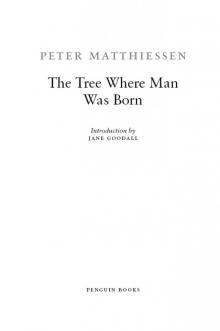 The Tree Where Man Was Born
The Tree Where Man Was Born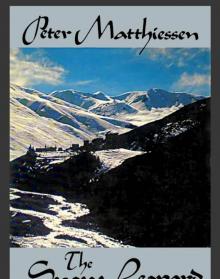 The Snow leopard
The Snow leopard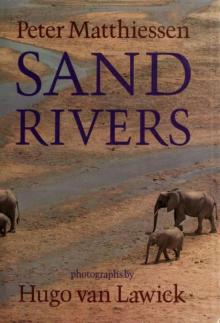 Sand Rivers
Sand Rivers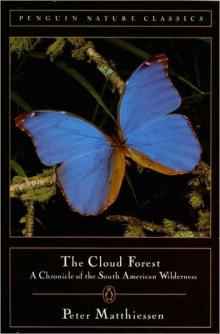 The Cloud Forest
The Cloud Forest Sal Si Puedes (Escape if You Can)
Sal Si Puedes (Escape if You Can) Far Tortuga
Far Tortuga Men's Lives
Men's Lives On the River Styx: And Other Stories
On the River Styx: And Other Stories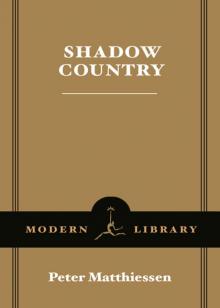 Shadow Country
Shadow Country At Play in the Fields of the Lord
At Play in the Fields of the Lord Lost Man's River
Lost Man's River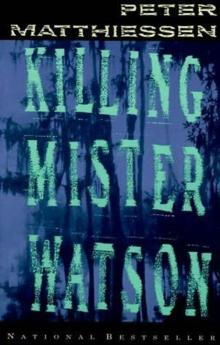 Killing Mister Watson
Killing Mister Watson On the River Styx
On the River Styx